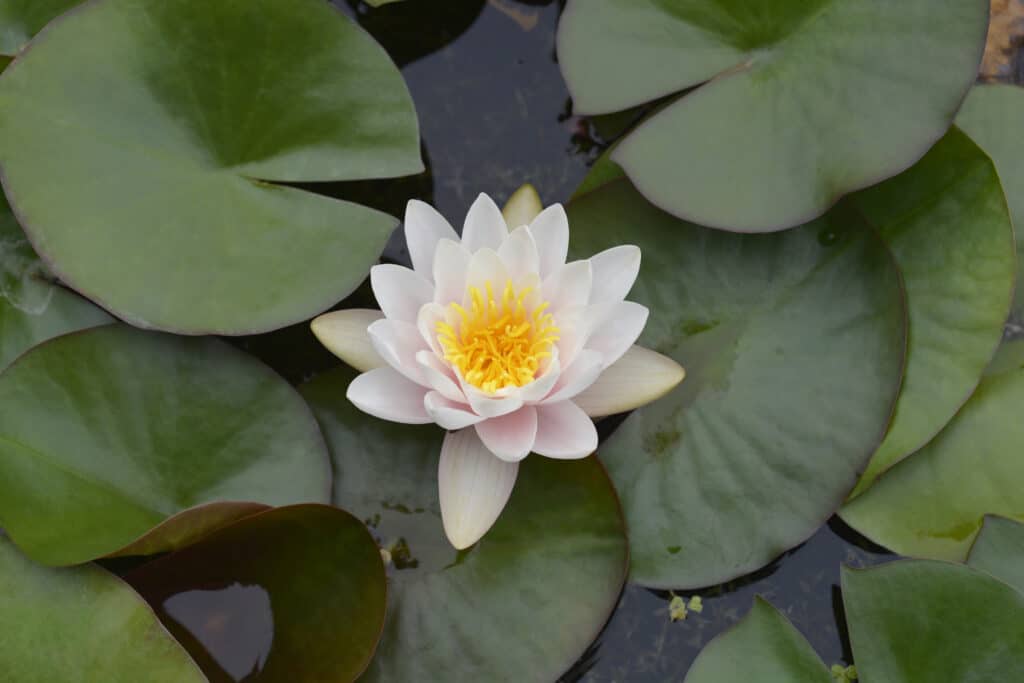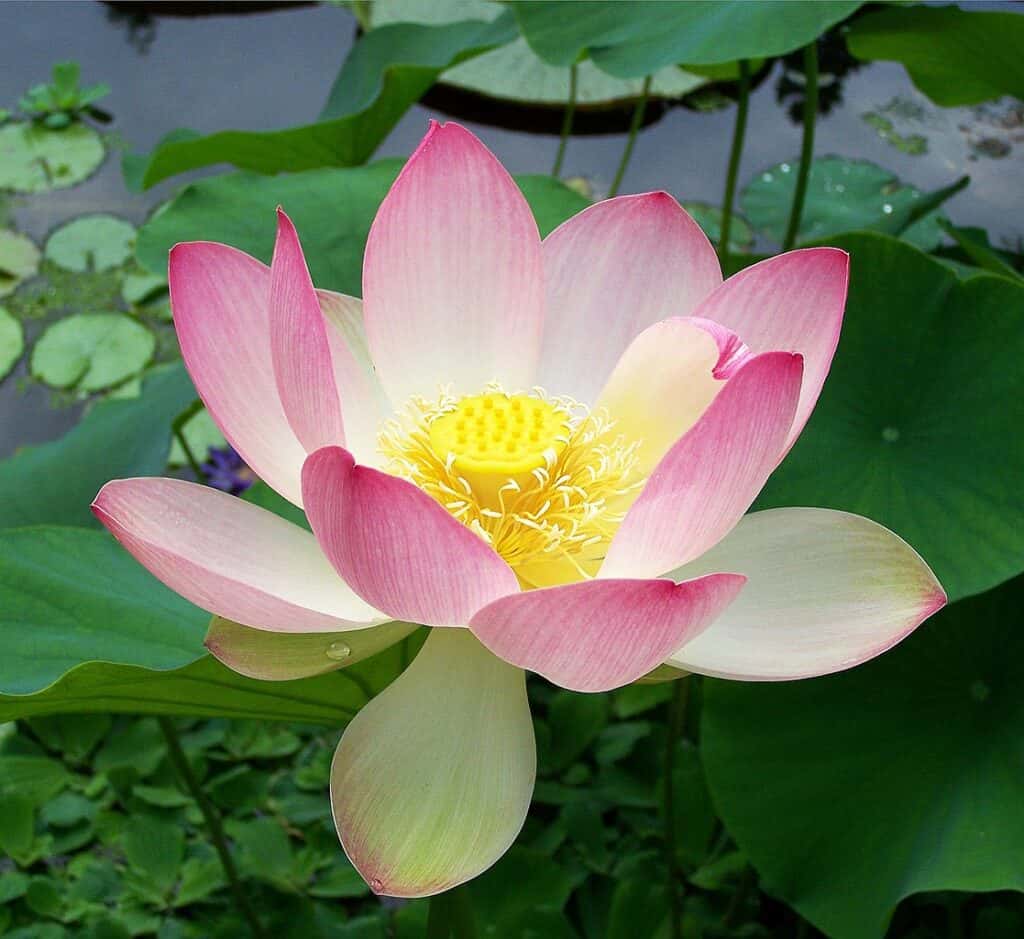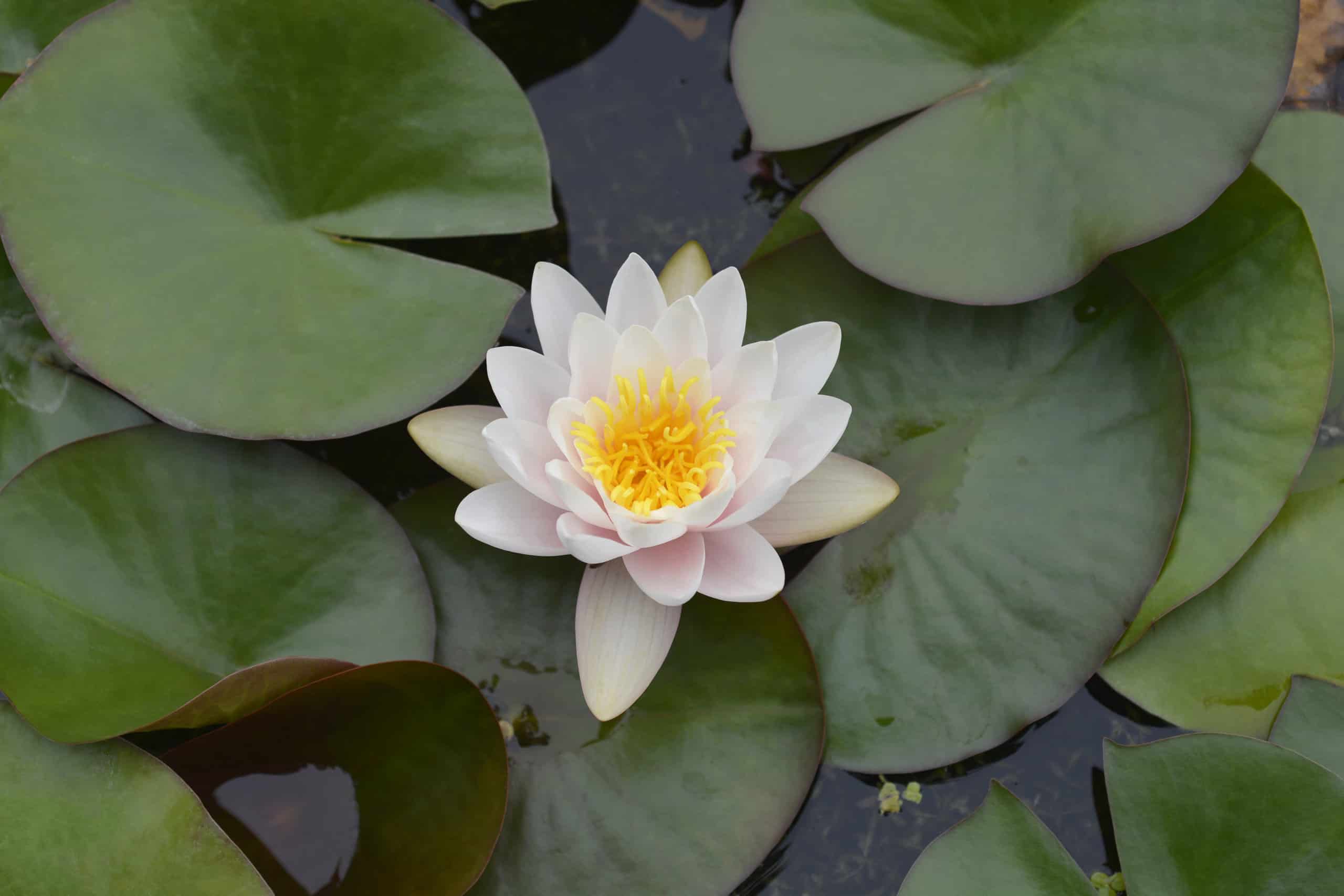Water lilies and lotuses look very similar and are often confused with one another. They both have a very similar growth pattern and flower, so it is no wonder they are hard to tell apart. But there are a few differences between these two plants, such as the shape of the petals, the flower’s height, and the bloom’s scent.
We will discuss the similarities and differences between water lilies and lotuses in more detail below.
Comparing Water Lily vs. Lotus
| Characteristic | Water Lily | Lotus |
|---|---|---|
| Scientific Name | Nymphaeaceae | Nelumbo |
| Common Names | Water lily | Lotus, sacred lotus, Laxmi lotus, Indian lotus |
| Native Region | North America | Eastern and southern Asia, Australia |
| Description | Leaves float on the water. A characteristic notch from the edge into the center of the lily pad. Pointy leaves that are thick and waxy. Bloom looks like a star | Leaves are emergent and rise 6-8″ above the water. Round or ruffled leaves that are thin and papery. Distinctive seed pod. |
| Color | Blooms are yellow, pink, red, pastel orange, and white | Blooms white, pink, blue, purple, or yellow |
| Scent | Blooms smell like lemon or cherry | Bloom smells floral with spicy citrusy and green undertones |
| Toxicity | Poisonous, it contains an alkaloid called nupharin | Edible, all parts of the plant |
| Water | Shallow water. Small cultivars 12″ of water. Large cultivars 3-4′ of water. USDA zones 4-10 for hardy varieties. Zones 9+ for tropical varieties. 6+ hours of sun | Deep water 12+ feet, although adaptable in cultivation. Hardy in USDA zones 5-10. Six hours of sun minimum per day |
The 5 Key Differences Between Water Lilies and Lotuses

Water lilies are beautiful white perennial plants that provide food for fish and wildlife.
©iStock.com/Nahhan
The main differences between a water lily and a lotus are the depth of the water in which they grow, the scent of the bloom, the shape of the flower, and the native area in which they grow. The water lily has a flower that floats on top of the water, while the lotus has an emergent bloom that hovers over the water without touching it.
We will discuss all of these differences in detail below.
Water Lily vs. Lotus: Name

Lotuses have distinctive flowers with petals that grow upright and never touch the water.
Water lily only has one common name, water lily! This is pretty unusual in the world of plants, as humans love to give them nicknames.
The scientific name for a water lily is Nymphaeaceae.
The lotus is also called the sacred lotus, Indian lotus, and Laxmi lotus. The scientific name for a lotus is Nelumbo.
Water Lily vs. Lotus: Description

Water lilies have a distinctive lily pad with a notch whereas lotuses have perfectly round pads.
©iStock.com/Marina Denisenko
The biggest difference between a lily and a lotus is the shape of the leaves and flowers. The water lily grows a big lily pad with a notch, while the lotus grows a perfectly round lily pad.
Water lilies also have leaves that float directly on the water, while lotus leaves hover above the water by six inches or more. Water lilies have pointy leaves that are thick and waxy. The lotus plant has round leaves that are thin and papery.
Water Lily vs. Lotus: Bloom Color and Scent
Water lily blooms come in yellow, pink, red, pastel orange, and white. Lotus blooms come in white, pink, blue, purple, or yellow.
Water lilies smell sweet and tarty, like a lemon or cherry candy. However, lotus flowers smell intensely floral with hints of citrus and spice.
Water Lily vs. Lotus: Toxicity

All water lilies are poisonous and should not be consumed
©iStock.com/Harry Adam
Water lilies are poisonous as they contain an alkaloid called nupharin which is toxic to humans and pets, although not deadly. In previous eras, it was thought to hold medicinal properties, but it is no longer used in this way.
The lotus plant is entirely edible. Every part of a lotus flower is commonly eaten raw or cooked in many parts of the world. The underground tuber is high in starch and is eaten baked or boiled. The seeds taste good raw, dried, or ground into flour. Even the stem fibers are used to make a fine lotus silk cloth.
Water Lily vs. Lotus: Growing Requirements

Although lotus plants prefer deep water when they are in the wild, they can adapt to shallower backyard ponds
©iStock.com/Maria Marganingsih
Water lilies require full sun, at least six hours of sun per day, and of course, water. They prefer water on the shallow end, making it a favorite for backyard pond owners. The smaller cultivars will grow happily in a bucket with only 12 inches of water, while the larger cultivars need three or four feet of water to grow. The water lily is hardy in USDA zones 4 to10, which covers nearly the entire continent of North America. However, a tropical water lily is a tender plant that grows only in zones nine or above. It is a light feeder and requires only minimal fertilization.
Lotuses prefer deeper water. In nature, you will find it in still lakes up to twelve feet deep. However, in cultivation, it is readily adaptable to much shallower situations and can often be planted in backyard ponds that are only two feet deep. Lotuses needs at least six hours of sun daily and they hardy in USDA zones 5 to 10. The lotus plant is a heavy feeder and does require monthly fertilization during the growing season.
Are Water Lilies Called Lotus?
Both water lilies and lotus plants bloom in ponds, emerging from rhizomes and boasting a vibrant color range.
Distinguishing between them is straightforward: water lily flowers and leaves are thick and waxy, whereas lotus flowers and leaves are thin and papery.
Additionally, water lily leaves are recognizable by the presence of a distinct notch in each leaf.
Water lilies contrast with lotus plants as they either grow directly on or slightly above the water’s surface. In some instances, water lilies may appear to be “elevated” above the water’s surface, but this phenomenon is attributable to tidal fluctuations, given that the Gardens are usually found in a tidal marshland linked to the Anacostia River.
Thank you for reading! Have some feedback for us? Contact the AZ Animals editorial team.








